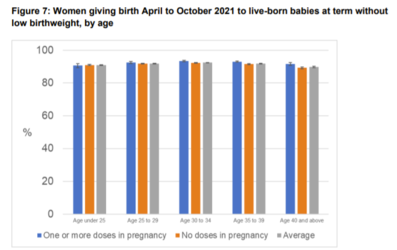In Nov 2021, UKHSA promised a more detailed break down to show recent numbers for pregnancy outcomes post vaccination. A monthly breakdown is what's needed. They have now published more but what they haven't published is quite telling.
https://assets.publishing.service.g...047/Vaccine_surveillance_report_-_week_47.pdf
The Nov publication included data from Jan to August and the remark "more detailed statistical analyses are planned". Every weekly publication since has included that remark but the detail has been hard to find.
https://www.gov.uk/government/publications/covid-19-vaccine-weekly-surveillance-reports
Women that were vaccinated before April included those who were most at risk of pregnancy complications. That is the reason UKHSA give for very slightly higher numbers of premature births in the vaccinated.

Therefore, in the more recent publication they looked separately at those who were dosed after April when women were invited based: "solely on age and not because they were considered at high risk of exposure or severe disease."
https://assets.publishing.service.g...2353/Vaccine_surveillance_report_-_week_5.pdf
There are still potential confounders e.g. socioeconomic differences. These differences have a large impact on pregnancy outcomes but, despite a culture of adjustments readily being made to make unfavourable data look favourable to the vaccine, these adjustments were never made.
Nevertheless the data presented in the latest report shows that the women who had healthy babies were just as likely to be vaccinated or not vaccinated, more likely in the older groups.
https://assets.publishing.service.g...2353/Vaccine_surveillance_report_-_week_5.pdf

However, all the remaining graphs in the report, which show separately the risks for premature births, low birth weight babies and stillbirths, still aggregate all the data from January to October.
No data is presented for stillbirths from April to October. Stillbirths are, thankfully, uncommon. That is why they need to be looked at separately. e.g. showing a % of healthy school children would not be evidence that there is no problem with childhood leukaemia.
The BBC reported on a rise in stillbirths recently in Scotland. This illustrates well how important monthly data is to notice a change.
https://www.bbc.co.uk/news/uk-scotland-59347464

It would be very odd if Scotland was seeing a phenomenon that wasn't also occuring in England. The cause is unknown, but failing to publish the data does not engender trust about: a) willingness to report a public health problem b) honest investigation of its cause.
The problem in Scotland in September may have been related partly to covid. Case numbers were higher in Sept than Jan or July according to the ONS. Surely, if covid were a problem the data should be released to educate pregnant women about covid risks.
https://www.ons.gov.uk/peoplepopula...iruscovid19infectionsurveypilot/29october2021
Pregnant women are being pressured to make a difficult decision on the basis of inadequate information. Noone can provide informed consent without being told the full picture.




